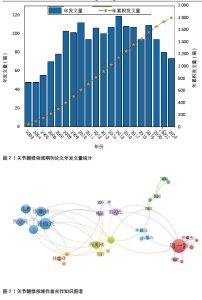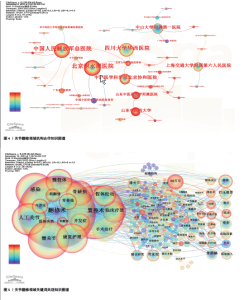Chinese Journal of Tissue Engineering Research ›› 2025, Vol. 29 ›› Issue (9): 1963-1971.doi: 10.12307/2025.157
Previous Articles Next Articles
Hot issues in the field of joint revision: infection, rehabilitation nursing, bone defect, and prosthesis loosening
Liang Haobo1, Wang Zeyu1, Ma Wenlong1, 2, Liu Hao1, Liu Youwen1, 2
- 1School of Orthopedics and Traumatology, Henan University of Chinese Medicine, Zhengzhou 450016, Henan Province, China; 2Luoyang Orthopedic Hospital of Henan Province (Orthopedic Hospital of Henan Province), Luoyang 471000, Henan Province, China
-
Received:2024-01-06Accepted:2024-03-22Online:2025-03-28Published:2024-10-11 -
Contact:Liu Youwen, Professor, Doctoral supervisor, Chief physician, School of Orthopedics and Traumatology, Henan University of Chinese Medicine, Zhengzhou 450016, Henan Province, China; Luoyang Orthopedic Hospital of Henan Province (Orthopedic Hospital of Henan Province), Luoyang 471000, Henan Province, China -
About author:Liang Haobo, Master candidate, School of Orthopedics and Traumatology, Henan University of Chinese Medicine, Zhengzhou 450016, Henan Province, China -
Supported by:National Natural Science Foundation of China, No. 82074472 (to LYW); Henan Province Traditional Chinese Medicine Science Research Special Project, No. 20-21ZYZD10 (to LYW)
CLC Number:
Cite this article
Liang Haobo, Wang Zeyu, Ma Wenlong, Liu Hao, Liu Youwen. Hot issues in the field of joint revision: infection, rehabilitation nursing, bone defect, and prosthesis loosening[J]. Chinese Journal of Tissue Engineering Research, 2025, 29(9): 1963-1971.
share this article
Add to citation manager EndNote|Reference Manager|ProCite|BibTeX|RefWorks
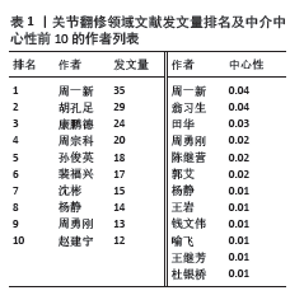
2.1 年发文量分析 发文量是科研机构实力强弱的重要表现,以已发表的文献量作为重要参考指标[21]。由图2可知,近20年间关节翻修领域相关文献年发文量的整体态势趋于稳定,其中2003-2005年间相关研究报道较少,处于低产稳定期;2006-2015年,发文量虽有所波动,但整体进入增长阶段,并在2015年达到年发文量的高峰,为119篇,说明了关节翻修领域的研究热度高涨,其研究价值受到临床医生和相关领域科学家的关注;2016-2022年间由于不可抗拒因素,处于波动性下降期,但是其累计发文量曲线持续稳定上升,其增长趋势与线性增长模型吻合度较高 (R2=0.997 6),可见关节翻修领域文章增长趋势稳定,表明该领域拥有巨大的发展潜力;自2006年以来,连续15年发文量在70篇以上,这提示近15年来对翻修术领域的研究日益受到重视,已具有良好的研究基础。 2.2 作者合作分析 网络节点表示作者,网络节点的大小代表作者发表的文献数量,节点越大表示该作者发表的文献总数越多,节点之间连线表示作者之间的合作关系[22]。运用VOS viewer(1.6.20)软件对作者进行共现分析,导入的文献共有4 833位作者,关节翻修研究领域作者合作网络知识图谱见图3,图中显示的是发文量达到8篇及以上的作者。其中,发文量最多是周一新,为35篇;第2位是胡孔足,为29篇;第3位是康鹏德,为24篇,说明他们在关节翻修领域的研究较为活跃,在学科有积极影响力。中介中心性最高的是周一新和翁习生,为0.04,第3位是田华,为0.03,其余详见表1。根据普赖斯定律[23],核心作者最低发文量N=0.749√Mn max (Mn max为最高产作者发文量), Mn max=35,计算得出N=4。发文量达到4篇即为该领域的核心作者,共计308位。从图谱中分析可知,该领域主要形成了以周一新、翁习生、裴福兴、陈继营、周勇刚等为代表的核心研究团队。"

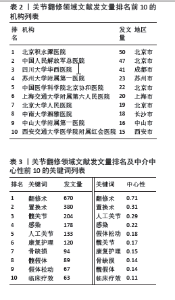
2.3 机构合作分析 可视化图谱可以为研究者提供该领域内研究力量的分布及各机构之间的合作信息,有利于加强学科间的交流与成果共享。使用Cite Space(6.2.R6)软件对纳入文献的机构进行分析,关节翻修研究领域机构合作网络知识图谱见图4,N=297,E=70。表2显示的是关节翻修领域文献发文量排名前10的机构。其中,北京积水潭医院发文量最高,为50篇;中国人民解放军总医院次之,为47篇;第3位是四川大学华西医院,为41篇;其余机构的发文量均低于25篇;说明北京积水潭医院、中国人民解放军总医院和四川大学华西医院3家机构在该研究领域处于遥遥领先的地位。中国人民解放军总医院的中介中心性为0.01,排名最高,其余机构的中介中心性均为0,说明各机构间中心性很低,未形成紧密的合作关系,未来还需进一步加强交流,以便各机构间的良好发展。发文量前10的机构中,有4家机构位于北京市,说明作为政治、经济与文化的中心,北京市的医疗技术发达、实力雄厚,且在关节翻修领域的研究处于国内居首地位,各地区应该加强与北京地区的医院开展多方位、深层次的交流合作。 2.4 关键词共现分析 关键词是文献中研究主题和内容的精炼概括和高度总结[24]。对文献进行关键词分析,可加深对该领域研究逻辑和理论基础的理解,有利于在一定程度上把握该领域的研究热点[25]。关键词节点的中心性反映该节点在整个图谱中的作用大小,值越大,节点越重要[26]。使用Cite Space(6.2.R6)和Excel(2016)对关键词进行整理筛选后得到283个关键词,对关键词出现频次进行统计,并利用Cite Space(6.2.R6)构建关键词共现网络(图5):N=283,E=516。表3展示了发文量排名前10的高频关键词和中介中心性前10的关键词列表,二者有所交叉。对图5和表3进行分析,高频关键词显示:关节翻修领域关注的热点是髋关节、感染、人工关节、康复护理、骨缺损、假体松动、临床疗效。同时,由图可知:人工关节、感染、假体松动、髋关节、康复护理、骨缺损、临床疗效也是关键的中心节点,起到了桥梁作用。"

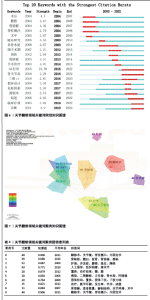
2.5 关键词突现分析 关键词突现是指在该关键词较短的一段时间内出现频次显著增加[27]。通过对突现词进行分析,可以判断某一特定时间突然显现或是逐渐兴起的创新思路,进一步反映研究的未来发展趋势[28]。关键词突现图谱中,红色部分代表某关键词爆发的起止时间,表明研究人员在此时间段内的研究兴趣急剧增加,蓝色则表示该关键词在某些年份的关注度较低。对关节翻修领域关键词突现知识图谱进行分析表明,3D打印是翻修术研究中突现强度最大的关键词,且与骨关节炎均是突现时间最长的关键词(图6)。从时间轴上分析,3D打印、骨关节炎从2016年起持续突现至2022年,说明在未来几年这两方面可能成为关节翻修研究领域的前沿热点,临床疗效和诊断从2019年突现且持续至2022年,是近年来翻修术研究领域的新兴热点。 2.6 关键词聚类分析 关键词聚类图谱可以表明该领域的不同研究关注点,在关键词共现图谱的基础上采用对数似然率算法对不同聚类标签进行标识以确定研究热点[29]。图中包含了10个具有代表性的聚类标签,编号越小,则聚类的规模越大,也就是聚类中包含的关键词数量越多。运用Cite Space(6.2.R6)软件,得到关节翻修领域关键词聚类知识图谱(图7),聚类的节点数越多、研究热点越高,其聚类序号越小。Q值=0.523 4,S值=0.850 8,满足Q值> 0.3,S值> 0.7,提示关键词聚类结构具有显著意义且令人信服。图7显示,形成了#0翻修术、#1骨缺损、#2护理、#3人工假体、#4置换、#5感染、#6假体松动、#7治疗、#8骨溶解、#9肌腱,共10个有意义的聚类(表4)。其中,聚类#1、#5、#6、#8主要探讨置换后翻修的主要问题;聚类#2、#7主要研究翻修术后至关重要的影响因素。"

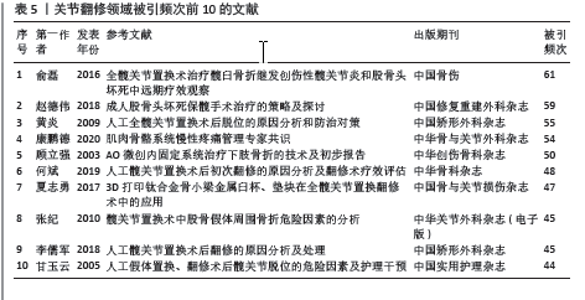
2.7 关节翻修领域高被引文献分析 高被引论文代表着在该领域内论文受到学者的广泛认可,总结高被引论文有助于探索学术领域的研究前沿和热点,进而发现学术领域内未来的研究方向。表5中列出了2003-2022年来关节翻修领域被引频次排名前10的参考文献。这些是关节翻修领域具有很高学术参考价值的文献,也是研究该领域需要重点关注的文献。 俞磊等[30]研究发现全髋关节置换治疗髋臼骨折继发创伤性髋关节炎和(或)股骨头坏死的33例患者假体10年生存率为84.8%,其中3例由于假体无菌性松动行翻修手术。赵德伟等[31]对成人股骨头坏死的保髋手术治疗方法进行综述,认为手术方案的选择和临床疗效是股骨头坏死保髋手术的主要问题。黄炎等[32]回顾并分析15例全髋关节置换术后脱位的患者,认为全髋关节置换术后脱位与是否翻修、手术入路、假体位置的安放等因素有关。康鹏德等[33]认为关节置换术后由于假体周围感染、假体周围骨溶解、假体松动等原因导致的慢性疼痛,进而影响患者正常生活,需要进行关节翻修术治疗。顾立强等[34]研究发现AO微创内固定系统适用于全髋关节置换或翻修(长柄型)术后同侧股骨干远段骨折、膝关节置换假体周围骨折以及骨缺损等,是一种有效的微创内固定治疗方法。何斌等[35]研究结果证明髋关节置换术后初次翻修的主要原因为假体无菌性松动,翻修术后再次手术的主要原因为假体脱位,55岁以下的翻修患者术后再翻修风险更高。夏志勇等[36]研究发现3D打印钛合金骨小梁金属臼杯和垫块应用于15例全髋关节置换翻修患者术后均无假体脱位、松动等并发症出现,短期疗效较好,但长期疗效有待进一步研究。张纪等[37]研究发现髋关节翻修术中股骨假体周围骨折的发生率(21.4%)远高于初次髋关节置换术中股骨假体周围骨折的发生率(4.0%),假体周围骨折的主要影响因素是翻修时的骨质状况。李儒军等[38]也发现人工髋关节翻修的最常见原因是假体松动,其他原因包括感染、脱位、假体磨损、假体周围骨折等诸多原因。甘玉云[39]认为术前、术后护理有效干预可以明显降低关节置换和翻修术后众多并发症如假体脱位、肌肉萎缩及肺炎等的发生。"

| [1] SCHWARTZ BE, PIPONOV HI, HELDER CW, et al. Revision total hip arthroplasty in the United States: national trends and in-hospital outcomes. Int Orthop. 2016; 40(9):1793-1802. [2] BADARUDEEN S, SHU AC, ONG KL, et al. Complications After Revision Total Hip Arthroplasty in the Medicare Population. J Arthroplasty. 2017;32(6):1954-1958. [3] KAHLENBERG CA, SWARUP I, KRELL EC, et al. Causes of Revision in Young Patients Undergoing Total Hip Arthroplasty. J Arthroplasty. 2019;34(7):1435-1440. [4] BOZIC KJ, KURTZ SM, LAU E, et al. The epidemiology of revision total hip arthroplasty in the United States. J Bone Joint Surg Am. 2009;91(1):128-133. [5] SCHWARTZ AM, FARLEY KX, GUILD GN, et al. Projections and Epidemiology of Revision Hip and Knee Arthroplasty in the United States to 2030. J Arthroplasty. 2020;35(6S):S79-S85. [6] 张凯,张晓勃,施锦涛,等. 长间充质干细胞治疗椎间盘退行性疾病:基于Web of Science数据库的文献计量及可视化分析[J]. 中国组织工程研究,2021,25(19):3031-3038. [7] Cancino CA, Merigó JM, Coronado F, et al. Forty years of Computers & Industrial Engineering: A bibliometric analysis. Comput Ind Eng. 2017;113:614-629. [8] WU F, GAO J, KANG J, et al. Knowledge Mapping of Exosomes in Autoimmune Diseases: A Bibliometric Analysis (2002-2021). Front Immunol. 2022;13:939433. [9] SUN HL, BAI W, LI XH, et al. Schizophrenia and Inflammation Research: A Bibliometric Analysis. Front Immunol. 2022;13:907851. [10] PENG C, KUANG L, ZHAO J, et al. Revision total hip arthroplasty in the United States: national trends and in-hospital outcomes Bibliometric and visualized analysis of ocular drug delivery from 2001 to 2020. J Control Release. 2022;345:625-645. [11] DONG X, TAN Y, ZHUANG D, et al. Global Characteristics and Trends in Research on Ferroptosis: A Data-Driven Bibliometric Study. Oxid Med Cell Longev. 2022;2022:8661864. [12] 温帅波,韩杰,吴钰坤. 来自Web of Science数据库软骨修复15年相关文献的计量学及可视化分析[J]. 中国组织工程研究,2021,25(17):2657-2663. [13] XIU R, SUN Q, LI B, et al. Mapping Research Trends and Hotspots in the Link between Alzheimer’s Disease and Gut Microbes over the Past Decade: A Bibliometric Analysis. Nutrients. 2023;15(14):3203. [14] WU H, CHENG K, TONG L, et al. Knowledge structure and emerging trends on osteonecrosis of the femoral head: a bibliometric and visualized study. J Orthop Surg Res. 2022;17(1):194. [15] 和映玉,邓清月,李仙仙,等. 基于VOSviewer和CiteSpace的菟丝子知识图谱可视化分析[J]. 中草药,2023,54(15): 4958-4972. [16] ZHONG D, LI Y, HUANG Y, et al. Molecular Mechanisms of Exercise on Cancer: A Bibliometrics Study and Visualization Analysis via CiteSpace. Front Mol Biosci. 2022;8:797902. [17] XU P, LV T, DONG S, et al. Association between intestinal microbiome and inflammatory bowel disease: Insights from bibliometric analysis. Comput Struct Biotechnol J. 2022;20:1716-1725. [18] CHEN JW, GUAN Y, ZHENG YL, et al. Research trends and frontiers in exercise for movement disorders: A bibliometric analysis of global research from 2010 to 2021. Front Aging Neurosci. 2022;14:977100. [19] 刘光阳. CiteSpace国内应用的传播轨迹——基于2006-2015年跨库数据的统计与可视化分析[J]. 图书情报知识, 2017(2):60-74. [20] TAO S, YANG D, ZHANG L, et al. Knowledge domain and emerging trends in diabetic cardiomyopathy: A scientometric review based on CiteSpace analysis. Front Cardiovasc Med. 2022;9:891428. [21] JOSHI MA. Bibliometric indicators for evaluating the quality of scientifc publications. J Contemp Dent Pract. 2014; 15(2):258-262. [22] CHENG P, TANG H, DONG Y, et al. Knowledge Mapping of Research on Land Use Change and Food Security: A Visual Analysis Using CiteSpace and VOSviewer. Int J Environ Res Public Health. 2021;18(24):13065. [23] LONG H, YUAN Z, YIN H, et al. Global Research Trends in Tendon Stem Cells from 1991 to 2020: A Bibliometric and Visualized Study. Stem Cells Int. 2022;2022:7937765. [24] WANG S, ZHANG L, JIN Z, et al. Visualizing temporal dynamics and research trends of macrophage-related diabetes studies between 2000 and 2022: a bibliometric analysis. Front Immunol. 2023;14:1194738. [25] JU Y, LONG H, ZHAO P, et al. The top 100 cited studies on bacterial persisters: A bibliometric analysis. Front Pharmacol. 2022;13:1001861. [26] 陈悦,陈超美,刘则渊,等. CiteSpace知识图谱的方法论功能[J]. 科学学研究, 2015,33(2):242-253. [27] 王艳秋,孟翔鹤,秦静波,等. 基于Citespace的中医药治疗过敏性紫癜可视化分析[J]. 中国实验方剂学杂志,2020, 26(10):173-179. [28] 潘桔红,陈粤瑛,胡玉刚,等. 巨噬细胞极化在动脉粥样硬化中研究演变的可视化分析[J]. 中国医学科学院学报,2023, 45(4):608-617. [29] 樊玉录,方中坚,姚虹,等. 我国医药创新研究进展的CiteSpace可视化分析[J]. 中国新药杂志,2023,32(9): 878-885. [30] 俞磊,张成欢,郭亭,等. 全髋关节置换术治疗髋臼骨折继发创伤性髋关节炎和股骨头坏死中远期疗效观察[J]. 中国骨伤,2016,29(2):109-113. [31] 赵德伟,谢辉. 成人股骨头坏死保髋手术治疗的策略及探讨[J]. 中国修复重建外科杂志,2018,32(7):792-797. [32] 黄炎,孔荣,方诗元,等. 人工全髋关节置换术后脱位的原因分析和防治对策[J]. 中国矫形外科杂志,2009,17(5): 333-335. [33] 康鹏德,黄泽宇,李庭,等. 肌肉骨骼系统慢性疼痛管理专家共识[J]. 中华骨与关节外科杂志,2020,13(1):8-16. [34] 顾立强,王大平,相大勇,等. AO微创内固定系统(LISS)治疗下肢骨折的技术及初步报告[J]. 中华创伤骨科杂志,2003, 5(4):361-364. [35] 何斌,章淼锋,沈跃,等. 人工髋关节置换术后初次翻修的原因分析及翻修术疗效评估[J]. 中华骨科杂志,2019,39(15): 909-917. [36] 夏志勇,马康康,李凯,等. 3D打印钛合金骨小梁金属臼杯、垫块在全髋关节置换翻修术中的应用[J]. 中国骨与关节损伤杂志,2017,32(2):121-124. [37] 张纪,周一新,周乙雄. 髋关节置换术中股骨假体周围骨折危险因素的分析[J]. 中华关节外科杂志(电子版),2010,4(4): 488-493. [38] 李儒军,陶可,寇伯龙,等. 人工髋关节置换术后翻修的原因分析及处理[J]. 中国矫形外科杂志,2018,26(19): 1729-1734. [39] 甘玉云. 人工假体置换、翻修术后髋关节脱位的危险因素及护理干预[J]. 中国实用护理杂志,2005,21(11):24-25. [40] CHEN C, SONG M. Visualizing a field of research: A methodology of systematic scientometric reviews. PLoS One. 2019; 14(10):e0223994. [41] ELLEGAARD O, WALLIN JA. The bibliometric analysis of scholarly production: How great is the impact? Scientometrics. 2015; 105(3):1809-1831. [42] CHEN C, LEYDESDORFF L. Patterns of connections and movements in dual-map overlays: A new method of publication portfolio analysis. J Assoc Inform Sci Technol. 2013;65(2):334-351. [43] 周一新,邓旺,王兆伦,等. 内侧膝关节单髁置换术失败行全膝关节置换术的手术技术及临床疗效[J]. 中华骨与关节外科杂志,2023,16(11):981-988. [44] 胡孔足.55岁以下年轻患者全髋置换术的中期假体生存率[J].临床骨科杂志,2023, 26(2):302. [45] LIU Q, TIAN Z, PIAN K, 等.下肢关节镜术对后续关节置换术的影响:一项系统性回顾和Meta分析[J].临床骨科杂志,2023, 26(3):322. [46] 陈志,林佳俊,刘文革,等. 髋关节和膝关节翻修手术前预防性抗生素使用的必要性与策略[J]. 国际骨科学杂志,2020, 41(3):148-151. [47] 刘鑫,罗翼,何宣虹,等.3D打印定制半骨盆假体在组配式半骨盆假体无菌性松动或螺钉断裂患者翻修中的应用[J].中国修复重建外科杂志,2023,37(10): 1183-1189. [48] 徐哲,田广,谢阳江,等. 3D打印假体翻修置换伴复杂髋臼缺损的假体失败[J].中国矫形外科杂志,2022,30(20): 1880-1883. [49] 张超凡,方心俞,黄子达,等. 二期人工全髋关节翻修术治疗慢性化脓性髋关节炎的疗效分析[J].中华创伤骨科杂志, 2021,23(12):1063-1070. [50] 李章来,沈凯魏,肖垚,等. 直接前方入路行髋关节翻修术的临床疗效研究[J]. 中华骨与关节外科杂志,2022,15(4): 262-268. [51] 李志伟,张博,刘蓉,等. X射线、MRI及SPECT/CT对全髋关节置换术后假体周围骨溶解的诊断效能比较[J].中国现代医学杂志,2022,32(11):14-19. [52] 陈悦,刘则渊. 悄然兴起的科学知识图谱[J].科学学研究,2005,23(2):149-154. |
| [1] | Sun Xiaojun, Wang Huaming, Zhang Dehong, Song Xuewen, Huang Jin, Zhang Chen, Pei Shengtai. Effect of finite element method in treatment of developmental dysplasia of the hip in children [J]. Chinese Journal of Tissue Engineering Research, 2025, 29(9): 1897-1904. |
| [2] | Zhou Jinhai, Li Jiangwei, Wang Xuquan, Zhuang Ying, Zhao Ying, Yang Yuyong, Wang Jiajia, Yang Yang, Zhou Shilian. Three-dimensional finite element analysis of anterior femoral notching during total knee arthroplasty at different bone strengths [J]. Chinese Journal of Tissue Engineering Research, 2025, 29(9): 1775-1782. |
| [3] | Lyu Liting, Yu Xia, Zhang Jinmei, Gao Qiaojing, Liu Renfan, Li Meng, Wang Lu. Bibliometric analysis of research process and current situation of brain aging and exosomes [J]. Chinese Journal of Tissue Engineering Research, 2025, 29(7): 1457-1465. |
| [4] | Xie Liugang, Cui Shuke, Guo Nannan, Li Aoyu, Zhang Jingrui. Research hotspots and frontiers of stem cells for Alzheimer’s disease [J]. Chinese Journal of Tissue Engineering Research, 2025, 29(7): 1475-1485. |
| [5] | Chang Jinxia, Liu Yufei, Niu Shaohui, Wang Chang, Cao Jianchun. Visualization analysis of macrophage polarization in tissue repair process [J]. Chinese Journal of Tissue Engineering Research, 2025, 29(7): 1486-1496. |
| [6] | Li Huijun, Li Huangyan, Zhang Yeting. Physical activity and cognition in older adults: research hotspot and topic evolution [J]. Chinese Journal of Tissue Engineering Research, 2025, 29(5): 1073-1080. |
| [7] | Dang Xiaowen, Huang Hailiang, Huang Lei, Wang Yajie . Research frontiers and hotspots of carbon nanomaterials in biomedical field over the past 10 years [J]. Chinese Journal of Tissue Engineering Research, 2025, 29(4): 752-760. |
| [8] | Wang Chen, Zhang Weinan, Shen Jining, Liu Fan, Yuan Jishan, Liu Yake. Inhibitory effect of ferroptosis inhibitor toxicity induced by cobalt nanoparticles through reactive oxygen species [J]. Chinese Journal of Tissue Engineering Research, 2025, 29(34): 7310-7317. |
| [9] | Ma Yucong, Ouyang Zhengzheng, Liu Xiaojie, Yang Sifei. Tracking of research trends and hotspots in medical magnesium alloy materials [J]. Chinese Journal of Tissue Engineering Research, 2025, 29(34): 7470-7480. |
| [10] | Wang Rongqiang, Yang Liu, Wu Xiangkun, Shang Lilin. Analysis of factors associated with prognosis of osteoporosis patients after hip arthroplasty and construction of Nomogram prediction model [J]. Chinese Journal of Tissue Engineering Research, 2025, 29(33): 7137-7142. |
| [11] | Abuduainijiang·Abulimiti, Alimu·Mamuti, Li Simi. Artificial femoral head replacement for femoral neck fracture in the elderly: validation of a risk prediction model for hip dysfunction [J]. Chinese Journal of Tissue Engineering Research, 2025, 29(33): 7143-7149. |
| [12] | Liu Ning, Sun Yingjin, Huang Long, Feng Shuo, Chen Xiangyang. Optimal rotational alignment of the tibial component during Oxford unicompartmental knee arthroplasty [J]. Chinese Journal of Tissue Engineering Research, 2025, 29(33): 7158-7164. |
| [13] | Liao Qiyu, Ru Jiangying. Complications of intra-prosthetic dissociation after hip arthroplasty [J]. Chinese Journal of Tissue Engineering Research, 2025, 29(33): 7241-7249. |
| [14] | Wang Yong, Li Hongyu, Liu Yuhang, Wang Fengxing. Knowledge map of surgical treatment for osteonecrosis of the femoral head: a bibliometric analysis of data from 2005 to 2024 [J]. Chinese Journal of Tissue Engineering Research, 2025, 29(33): 7250-7260. |
| [15] | Deng Qing, Wang Qingjun, Zhang Yeting. Visual analysis of dynamic evolution of research topics in the field of physical activity and hippocampal tissue [J]. Chinese Journal of Tissue Engineering Research, 2025, 29(32): 6997-7003. |
| Viewed | ||||||
|
Full text |
|
|||||
|
Abstract |
|
|||||
